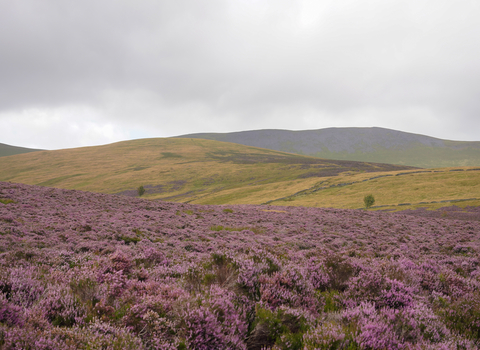Cumbria Wildlife Trust has plans to create England’s highest nature reserve, restoring an incredible 3,000+ acres, including peatlands and wildflower meadows, as well as bringing back 620 acres of temperate rainforest, thanks to The Wildlife Trusts’ partnership with Aviva (more about this here).
The creation of temperate rainforest on Skiddaw will be the largest attempt to revive Britain’s lost rainforests.
It marks a dramatic shift in the fate of this habitat and could herald the return of species not seen in this part of the Lake District for decades.
Returning woodland to the slopes of this iconic mountain may be far from straightforward. With winds battering the slopes and snowfall often lasting long into the spring, the growing season is quite short here, not to mention existing seed sources being a great distance away. But with a helping hand, grow the trees will. Of that I have no doubt.
We are not accustomed to seeing trees on the top of our hills and mountains in the UK, so many might think that they simply wouldn’t survive here. And yet, if you look at the heights of naturally occurring tree lines (the limits of tree growth due to altitude) at similar latitudes elsewhere, they are there. This new – and currently, mostly treeless – nature reserve sits at between 450-650 metres above sea level; compare this the Ural mountains in Russia – a direct line across the Earth from the UK – trees are growing up to around 1,100 metres above sea level and that’s without the benefit of our relatively stable oceanic climate.
It’s precisely this oceanic climate of the western UK that makes us so suited for temperate rainforest. Forests covered in mosses and lichens, where ferns grow in the branches of trees and the air is damp and humid, these are the woods of myths and legend, of King Arthur and his knights, of Ents and trolls.
The absence of these lost rainforest is a solely man-made situation. However, returning them is not as simple as it is to cut them down: woodlands support themselves, with the trees sheltering each other, creating stable micro-climates between them and even passing essential nutrients to each other. When they are all gone, getting them started up again can be tricky.
But through a mixture of planting, seeding and natural regeneration, the trees will slowly return. Once they get tall enough to shelter each other, they will start to work together to create new temperate rainforest habitat. What this habitat may look like is anyone’s guess... It might be a stunted woodland, where the action of the wind prevents the trees from growing tall and the canopy is only a few feet off the ground. Many of the northern Scottish rainforests are like this. Or perhaps the trees will grow tall but only after decades, with thick twisted trunks that give them strength and deep roots to lift up water and nutrients during the short growing season. We simply do not know.
What we do know is that the trees will return and whatever form they take, they will provide new opportunities for wildlife, branches for birds to perch on and hollows for small mammals to make their burrows and dens.
Once grown they will trap moisture, which aids the growth of lichens and mosses (in turn trapping more moisture), and as they decay create the organic matter of soils. This is of course great for locking up carbon from the atmosphere (helping to tackle climate change) and slowing the flow of water downstream (supporting flood prevention), holding it on the land for longer where plants can use it.
This will be the rainforest of the future. One day in decades to come, when you hike up Skiddaw there will be places to shelter from the wind and the sun, with roots to sit on and catch a moments rest, perhaps you’ll catch sight of a flycatcher snatching an insect in midair or a stoat darting across a path. These are the wildlife moments to come. Now is the start of an exciting journey.



